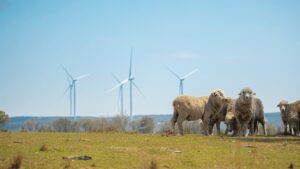
The competition for the biggest clean energy story of 2017 is intense.
Building and running new renewable energy is now cheaper than just running old coal and nuclear plants. The lowest price for solar power last year is the highestprice now. Battery prices were cut in half just since 2014.
And who could have imagined — just a few years after Tesla put a defibrillator to the flat-lined electric vehicle market — that China would announce plans to join the rapidly expanding list of countries planning to phase out fossil fuel-burning cars in the next decade or two, a list that by year’s end included the UK, France, Norway, and India?
It must always be repeated that the clean energy revolution can’t prevent catastrophic climate change without far more aggressive government policies to speed the transition off fossil fuels. And President Donald Trump can at least temporarily slow the revolution in the U.S. with his pro-polluter policies.
But the revolution is now unstoppable at a global level. That means the super-cheap solution to climate change is at hand — and in 2017, these individual technologies started to team up, joining their powers like the Marvel superheroes in the Avengers movies.
Solar remains the most amazing story. Solar panel prices plunged by a shocking 26 percent in the last year — despite having already dropped 80 percent in price in the previous 10 years and 99 percent since the late 1970s.

In a Saudi Arabian auction for a 300-megawatt (MW) solar farm this October, solar power crushed its own record for cheapest electricity “ever, anywhere, by any technology.”
Whereas in a March 2016 auction, the record low unsubsidized solar energy price was contracted at 3.6 cents per kilowatt-hour (kWh), every single bid Saudi Arabia received was cheaper than that. For context, the average U.S. commercial price for electricity is 11 cents/kWh.

Wind’s story is almost as amazing. In October, India saw the lowest bids in the world for 1000 MW of wind electricity at 2.64 rupees (4 U.S. cents) per kWh –a 24 percent drop just from February.
But perhaps the most remarkable wind energy story of 2017 is for building wind turbines offshore, where prices dropped a game-changing 28 percent in one year.
In April, Denmark’s Dong Energy won a German power auction for two offshore wind projects in the North Sea — without any government subsidies.
As the chief of business development at Siemens Gamesa Renewable Energy explained, “it’s staggering to think that in not much more than five years, we could have turned a technology seen as prohibitively expensive into the lowest cost, utility-scale technology available.”
Offshore wind is important to the growth of wind power for two reasons: first, it’s near where many people live. About half the U.S. population lives in coastal areas, for instance.
Second, with steadier winds, offshore farms typically deliver power that is less variable than onshore wind. An onshore wind farm might only produce 25 percent of its full power averaged over a year — a 25 percent capacity factor.
The best new offshore wind turbines, on the other hand, are already at a 50 percent capacity factor , and that may well rise to 60 percent and higher.
The battery revolution is another incredible story, one that will speed the renewable energy transition while enabling the rapid switch to electric cars.
Battery packs have dropped 75 percent since 2010 alone, as the top chart shows, and BNEF projects they will drop another 75 percent by 2030. The result is that “a price and energy cost analysis of conventional, hybrid, and electric vehicles illustrates that the EV has the lowest lifetime cost, even in a low-oil-price environment,” as the author of a GTM Research report on EVs explained.
This has led to soaring sales of battery electric vehicles (BEVs) worldwide, leaving hydrogen fuel cell vehicles (FCVs) — the only plausible competition for replacing fossil fuel powered vehicles — in the dust:
Meanwhile, battery technology advances have allowed Tesla’s Elon Musk to unveil an electric truck with a 500-mile range, and a “Roadster” with a 620-mile range.
Until very recently, electric vehicles typically had a range of under 200 miles, limiting the usefulness of EVs, especially in a world with a handful of (relatively slow) charging stations.
A 500+ mile range means you could do almost any kind of typical driving and then recharge overnight, either at home, or a hotel, or a shopping mall–or even a rest-station during dinner, since the latest super-chargers can already do a major recharge in a half hour.
As for the future, both BNEF and the International Energy Agency (IEA) now expect we will see EV sticker prices directly competitive with that of gas-powered cars within a decade — and they will continue to drop after that.
Yet, the EVs will offer superior performance and zero total emissions (running on renewable energy), and will be far cheaper to operate, especially as solar and wind power prices continue to plummet.
“More than 37 million plug-in electric vehicles are expected to be in use in 2025,” Navigant Research projected in January.
In July, BNEF projected that “electric cars will outsell fossil fuel-powered vehicles within two decades as battery prices plunge, turning the global auto industry upside down and signaling economic turmoil for oil-exporting countries.”
The plans by China, India, and others to phase out EVs could make this transition occur even faster.
So could the next generation solid-state lithium battery, which “delivers 2.5 times the energy density of typical lithium-ion batteries, with the potential of costing one third of the 2020 projected price of those batteries,” Green Car Congress reported. Such batteries could be charged in as short as one minute.
At the same time, deep penetration of renewables will be assisted by the dropping battery prices and soaring EV sales. As BNEF explains, “This will help renewable energy reach 74 percent penetration in Germany, 38 percent in the U.S., 55 percent in China, and 49 percent in India by 2040.”
Indeed, Energy Secretary Rick Perry’s own grid study came to a similar conclusion:
“An aggregated fleet of vehicles or chargers can act as a [demand response] resource, shifting load in response to price signals or operational needs; for example, vehicle charging could be shifted to the middle of the day to absorb high levels of solar generation and shifted away from evening hours when solar generation disappears and system net load peaks.”
As a result of all these technology advances working together, renewables will capture the lion’s share of the $10.2 trillion the world will invest in new power generation by 2040, BNEF projects in its annual New Energy Outlook 2017 report.

Solar and wind will make up nearly half of installed capacity and over one-third of global power generation by 2040. That’s a four-fold jump in wind capacity and a 14-fold jump in solar from today.
Finally, while high-visibility technologies like solar and wind and electric cars dominate the headlines, we’re seeing a continued explosion of the cheapest and cleanest source of electricity — using energy more efficiently, such as by replacing traditional lighting with LED bulbs.
Smarter, state-based utility regulations have led to a massive investment in energy efficiency in recent years. And that investment is a major reason why electricity demand in this country has been flat for nearly a decade, decoupling from economic growth.
The future is now.
Source: Think Progress. Reproduced with permission.











